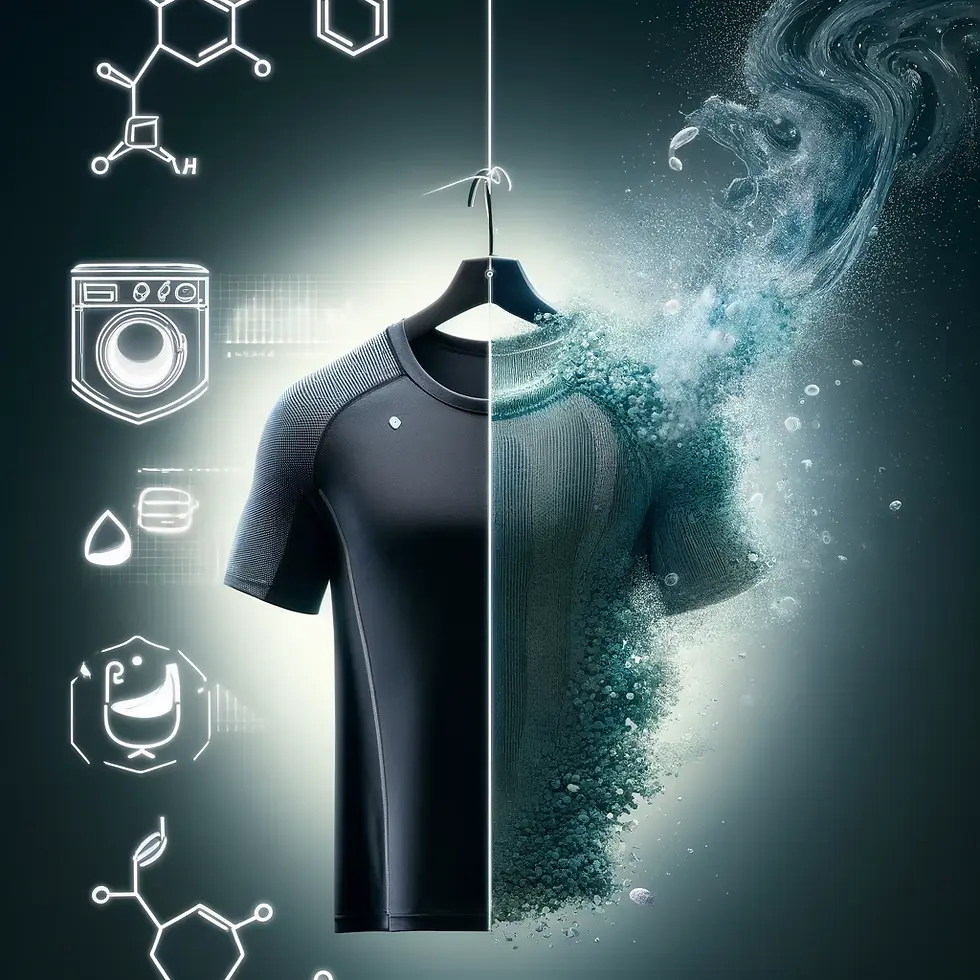[B028] - “Why That Spandex Gym Shirt Could Be Messing with Your Hormones”
- BOOSTGB
- Apr 21
- 4 min read
🧩 Introduction
You’ve cut back on canned food and plastic bottles. Great move. But what if the biggest BPA exposure in your life is hiding in your laundry basket? This surprising new study uncovers how everyday clothes, especially ones you've worn and washed repeatedly, could be exposing you—and your kids—to hormone-disrupting chemicals through your skin, not your mouth.
This is a must-read for parents, gym-goers, and anyone who sweats (a.k.a., all of us). Let’s dive in.

🧪 What the Research Shows
A study from China tested 93 garments (49 used, 44 new) and found widespread contamination with Bisphenol A (BPA) and its chemical cousin, Bisphenol S (BPS).
🧷 Key Findings:
100% of used clothes and 98% of new clothes had detectable BPA.
BPS was found in 29% of used clothes and 59% of new ones.
Median BPA level in used clothes: 34.2 nanograms per gram (ng/g)
Median in new clothes: 17.7 ng/g
Some synthetic garments (like polyester and Spandex blends) had BPA levels as high as 1,823 ng/g—more than 50x higher than average cotton clothing.
🧼 Cross-contamination during washing:
Why do used clothes have higher BPA levels?Because BPA spreads between garments in the wash—especially without detergent.
👕 “Source” clothes: items with high BPA levels
👚 “Receptor” clothes: items with low or no BPA, which absorb BPA during washing
Without detergent:
76% of BPA from the source item transferred to receptor clothes.
Cotton-based fabrics absorbed up to 220 ng/g, while synthetic blends absorbed less.
With detergent:
Transfer dropped to 54%, as detergent kept BPA suspended in water instead of sticking to clothes.
So yes—your T-shirt can “catch” BPA from other clothes during laundry, especially if you wash synthetics and cottons together.
💦 Sweaty Skin Exposure: Not Just a Kids’ Issue
Most people think kids are the most at-risk group—but if you're a gym-goer, runner, or someone who sweats a lot, this part's for you.
When researchers mimicked sweating on BPA-contaminated clothes, they found that BPA can leach through the fabric and into your skin.
🧒🏼 Wearing clothes with moderate BPA (34 ng/g):
Children absorbed up to 9.3 ng/kg of body weight per day
Adults absorbed up to 6.1 ng/kg of body weight per day
💧 Wearing high BPA clothes (199 ng/g):
Children: 52.1 ng/kg of body weight per day
Adults: 38.3 ng/kg of body weight per day
📊 For reference: BPA from dietary sources (like canned food) is often estimated around 30–50 ng/kg/day. That means your sweaty gym shirt might be exposing you to more BPA than your lunch.
📊 Facts About the Study
Title: Widespread Occurrence of Bisphenol A in Daily Clothes and Its High Exposure Risk in Humans
Authors: Wang L. et al.
Published: Environmental Science & Technology, May 2019
PMID: 31124657
Sample: 93 garments (used and new), sourced from 38 households in 3 Chinese cities
Textile types tested: Cotton (including blends), synthetic/artificial fibers, and unknown materials
⚠️ Study Limitations
Regional focus: All clothing samples came from China, which may affect how results generalise globally.
BPA absorption estimates: Dermal penetration was based on assumed rates (10% to 46%) from prior research.
Environmental influence not fully isolated: BPA could also come from air, dust, or washing machines.
Limited chemical scope: Focused mostly on BPA and BPS; other bisphenol analogues were not widely detected.
💡 Research to Action
Ready to reduce your family's hidden chemical exposure? Here are practical, science-backed steps:
🧴 Always wash with detergent: It reduces BPA transfer by up to 30%.
🧺 Wash baby clothes separately: Baby garments had lower BPA levels, likely because they’re rarely washed with synthetic items.
🌱 Prefer natural fibers: While cotton absorbs more BPA during washing, it starts off with far less than synthetics. Example:
Cotton: contain about 21 ng/g
Synthetics: contain about 65 ng/g
Polyester/Spandex: Over 1800 ng/g
🚫 Limit sweat-soaked wear: Especially for gym-goers—sweat drastically increases BPA absorption.
🧼 Wash new clothes before wearing to reduce surface-level BPA.
🚀 Boost Summary
BPA is an endocrine disruptor—a chemical that can interfere with hormones like oestrogen, testosterone, and thyroid hormones. That means even low-level exposure can affect fertility, growth, metabolism, and immune function.
This study shows that your clothes—especially used or sweaty ones—may be a major source of BPA exposure, comparable to food packaging like canned goods. Children are particularly at risk due to their smaller body size and larger skin surface relative to weight.
🎯 Whether you’re a parent, a fitness fan, or just someone doing laundry:
✔️ Wash smart [Use detergent]
✔️ Choose natural fibres and think twice about what goes into your laundry pile especially if you have children or spend your day on the move
👕➡️🛡️ Time to turn your wardrobe into a healthier space, one wash at a time.
📚 References
Wang L, Zhang Y, Liu Y, Gong X, Zhang T, Sun H. Widespread Occurrence of Bisphenol A in Daily Clothes and Its High Exposure Risk in Humans. Environ Sci Technol. 2019 May 24;53(12):7095-7102. doi: 10.1021/acs.est.9b02090. PMID: 31124657

![[B014] Microplastics and Your Family: The Alarming Truth About Everyday Containers](https://static.wixstatic.com/media/472320_7174f4bbd42c4f1f969a0465abc507fe~mv2.webp/v1/fill/w_980,h_980,al_c,q_85,usm_0.66_1.00_0.01,enc_avif,quality_auto/472320_7174f4bbd42c4f1f969a0465abc507fe~mv2.webp)




Comments